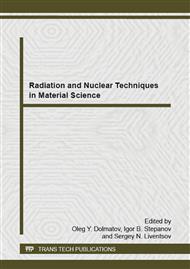p.393
p.400
p.406
p.409
p.413
p.417
p.422
p.426
p.430
Non-Invasive Tissue Injury Monitoring Using Bioimpedance Spectroscopy
Abstract:
An understanding of normal tissue response is necessary for the optimization of radiation treatment in cancer therapy. Cancer cells exhibit altered local dielectric properties compared to normal cells because of the difference in shape, size and orientation. These properties are measurable as a difference in electrical conductance using electrical impedance spectroscopy. Multiple frequency bioimpedance analysis is used to measure change in electrical properties of the irradiated tissues as a function of frequency and time. From the experimental results, it is clear that the electrical properties demonstrated good detection performance. The electrical parameters of the tissues could be used to distinguish the tissue's status. Changes in electrical properties at different frequencies show, that there are differences between conductivity of non-irradiated and irradiated tissues.
Info:
Periodical:
Pages:
413-416
Citation:
Online since:
January 2015
Keywords:
Price:
Сopyright:
© 2015 Trans Tech Publications Ltd. All Rights Reserved
Share:
Citation:


